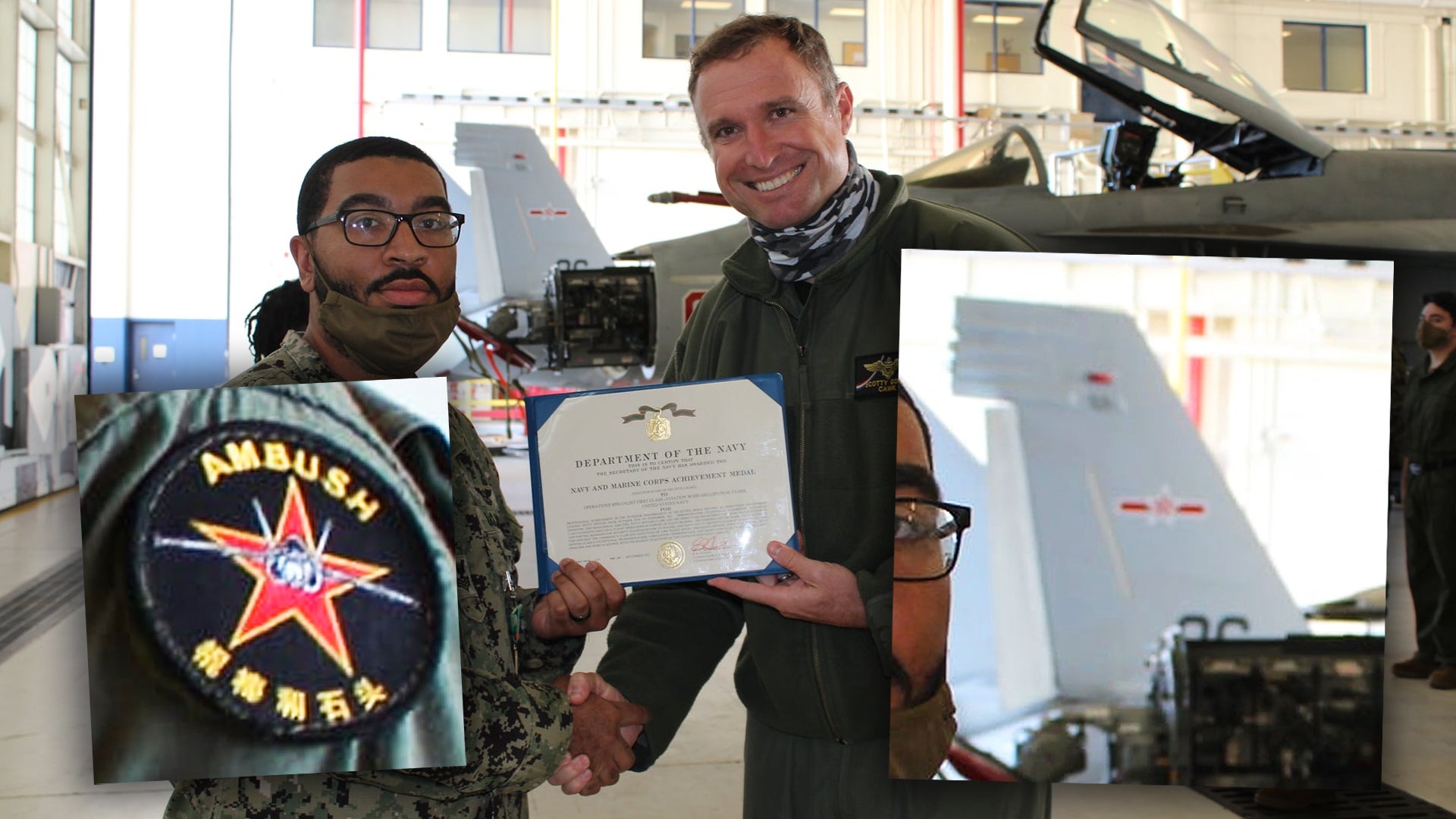The U.S. Navy’s Fighter Squadron Composite 12, or VFC-12, also known as the “Fighting Omars,” has released a picture that shows one of the unit’s F/A-18s sporting the national insignia of the Chinese military on the tail rather than a more typical Soviet/Russian-style red star. The unit, which also goes by its callsign, Ambush, is one of four squadrons in the Navy that provide specialized “red air” adversary training support. The War Zone was first to report last year that VFC-12 planned to apply entire new paint schemes mimicking those worn by Chinese jets, among others, to some of its new F/A-18E/F Super Hornets, reflecting a U.S. military-wide shift in attention to China as America’s so-called preeminent “pacing threat.”
The picture in question, which has no caption, appeared on VFC-12’s official Facebook page yesterday and is one of a series that shows the unit’s senior leaders handing out various awards and commendations. A public affairs officer for the unit told The War Zone that the aircraft in question is an otherwise “vanilla” F/A-18, but it’s not clear if it is one of the squadron’s F/A-18E/Fs or an older “legacy” Hornet.

That same public affairs officer said that VFC-12’s current plan is to start repainting its jets in the planned new schemes, which will also include ones that are meant to reflect various Russian, North Korean, and Iranian jets as well as Chinese types, in January. In June, the squadron did already debut a Super Hornet wearing a paint job known as the “Mako,” which is meant to mimic a camouflage pattern that first appeared on the fifth pre-production example of Russia’s T-50 advanced combat jet, a design now known as the Su-57.
Last year, VFC-12 provided artwork to The War Zone dreamed-up by Grant Little showing, among others, three different planned paint jobs based on the ones commonly worn by China’s J-10, J-11/J-16, and J-15 fighter jets. The J-10 is an indigenous design, variants of which are in service with the People’s Liberation Army Air Force (PLAAF) and the People’s Liberation Army Navy (PLAN). The J-11, J-15, and J-16, are all derived from the Soviet Su-27 Flanker. While the PLAAF and the PLAN both operate J-11s, the J-15 is a carrier-based type only flown by the PLAN, and the J-16 is a two seat-type only in service with the PLAAF.



Of course, it’s no secret that Navy, as well as U.S. Air Force aggressor jets have donned paint schemes representative of potential threats for years. However, when it comes to foreign-inspired paint jobs, a significant number of them have the ones in use by the Soviets, and now the Russian military. Many of those same schemes have been commonly used by other air arms around the world flying Soviet and Russian-made combat jets, as well. During the period around the end of the Cold War, some aggressors commonly wore insignia similar to that of potential threat countries. That practice generally had fallen by the wayside by the 2000s with the red star being something of a blanket insignia for the adversary community.

One of VFC-12’s F/A-18s carrying the Chinese national insignia — as the planned, more comprehensive PLAAF and PLAN-inspired schemes — reflects the Pentagon’s current view that China is now America’s “pacing threat.” This, in turn, means that developments in China are primary drivers of U.S. defense policy, doctrine, and acquisition decision-making across the U.S. military.

The impact of all of this on VFC-12’s day-to-day activities was already apparent earlier this year at a similar awards event. The squadron’s previous commanding officer, Cdr. Matt Runzel, handed out certificates while wearing an interesting patch, seen below, featuring a Hornet, viewed from the front, on top of a red star, along with “AMBUSH” written at the top. While plain red stars are more typically associated with the Soviet and Russian militaries, the patch also has an unknown phrase in Chinese characters written at the bottom.


The Pentagon’s increasing focus on China has also come amid growing concerns within the U.S. government about the potential for an actual conflict with the country, including over Taiwan or in the hotly disputed South China Sea. General geopolitical competition between the two countries is increasing, as well. In particular, recently disclosed Chinese tests of a new nuclear-capable fractional orbital bombardment system that employs a hypersonic glide vehicle earlier this year, which you can read more about here, coupled with other developments, are now raising fears of a new strategic arms race.
It’s therefore hardly surprising that the Fighting Omars are already beginning to paint some of their F/A-18s to reflect Chinese combat jets that Navy pilots might increasingly encounter during deployments, even outside of an actual conflict. The squadron’s specially-trained aggressor pilots are all but certainly increasingly trained to mimic the tactics, techniques, and procedures employed by the PLAAF and PLAN to further prepare naval aviators for any potential future engagement, as well.
With all this in mind, in the coming year, VFC-12 F/A-18s painted like Chinese jets to varying degrees look set to become a more common sight.
Editor’s note: Updated text to reflect that Grant Little was behind the new aggressor schemes that VFC-12 is applying to its jets. Hat tip to José “Fuji” Ramos for the heads up!
Contact the author: joe@thedrive.com
